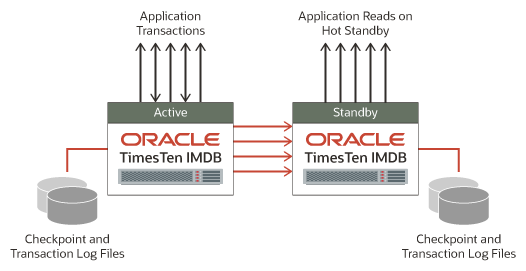About Provisioning Active Standby Pairs
TimesTen Classic databases almost always run in active standby pairs. Figure 1-1 illustrates an active standby pair replication scheme. There are two databases. One database is the active, and the second database is the standby. Applications update the active database. The standby database is read-only and receives replicated updates from the active database. Only one of the two databases function as the active database at any one time. If the active database fails, the standby database is promoted to be the active. After the failed (active) database is recovered, it becomes the standby database. See Types of Replication Schemes in the Oracle TimesTen In-Memory Database Replication Guide for more information on the active standby pair replication scheme.
Figure 1-1 Active standby pair of TimesTen databases

Description of "Figure 1-1 Active standby pair of TimesTen databases"
An active standby pair replication scheme is a good fit for Kubernetes. Specifically, consider a pair of Pods, each with persistent storage, that are running an active standby pair of TimesTen databases. If the Pod containing the active database fails, Kubernetes automatically spawns another Pod to take its place, and attaches the appropriate storage to it.
But, since Kubernetes doesn't know anything about TimesTen, it will not automatically perform the necessary operations to cause the standby database on the surviving Pod to become the active database. This is where the TimesTen Operator comes in.
TimesTen provides a CRD that adds the TimesTenClassic object type to Kubernetes as well as an Operator for managing TimesTen databases. The Operator automates setup and initial configuration, manages databases and replication, and automates failover and recovery.
When you define a TimesTenClassic object, you can specify the configuration of your TimesTen deployment using Kubernetes facilities. When you create a TimesTenClassic object in a Kubernetes cluster, a pair of Pods are created, each running TimesTen. Each Pod contains a TimesTen instance. Each instance provides one TimesTen database. Database replication, through active standby pairs, is automatically configured. In short, you can deploy highly available replicated pairs of TimesTen databases and manage them by issuing a small number of commands.
A Kubernetes Operator manages objects of a particular type. TimesTen provides an Operator that manages Kubernetes objects of type TimesTenClassic. In so doing, TimesTen can be deployed, monitored, managed, and controlled in an automated manner with no required human intervention.